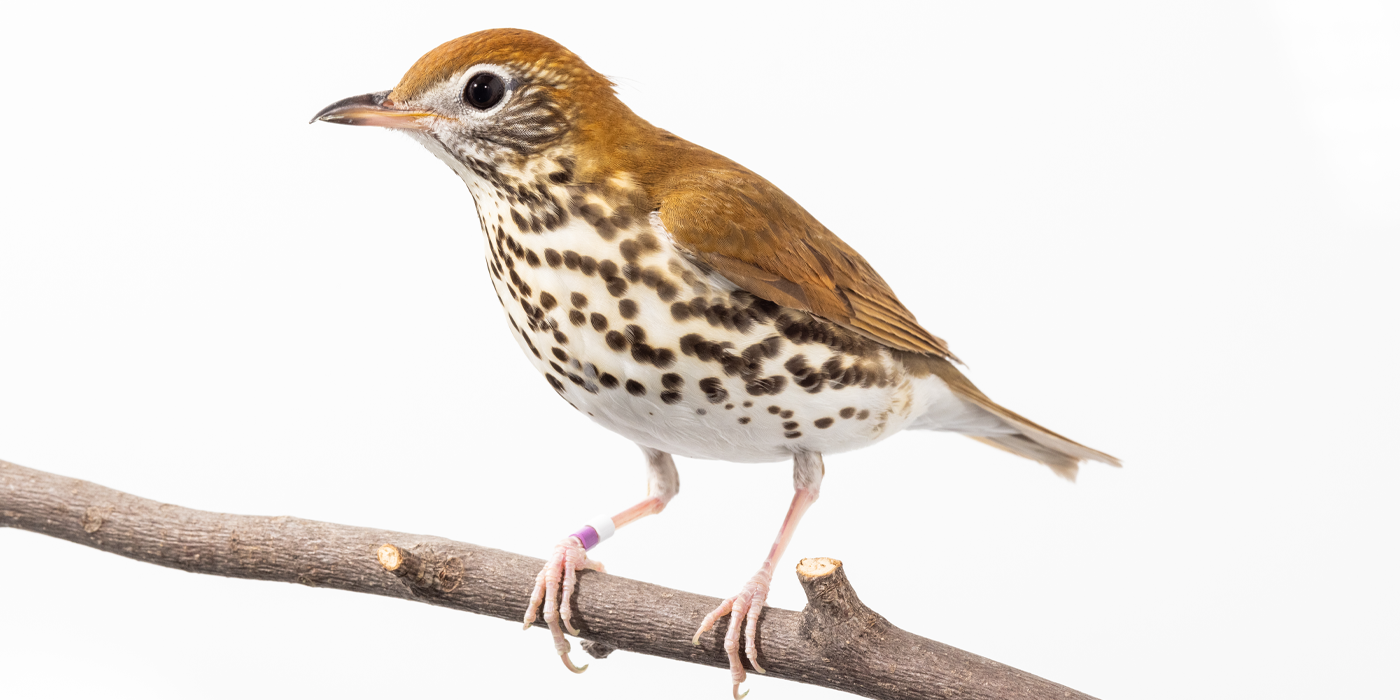Physical Description
The “weasel” in their scientific name refers to the rich, red-brown coloring on their head and the back of their neck. Their backs, wings and tail are a duller gray-brown. Their breasts and bellies are white with black or dark brown round spots like a Dalmatian’s. They have dull white rings around their eyes.
Like many other thrushes, wood thrushes have unusually large eyes, which helps them see and navigate in the shady forests they prefer.
Size
Native Habitat
Thick forests are a wood thrush’s preferred habitat. They can breed in almost any woodland, but have the best survival and reproduction rates in larger forests. Moist soil at the ground level is more important than forest density.
Wood thrushes breed throughout the eastern United States and southeastern Canada. For the winters, they migrate down to southern Mexico and Central America. Each wood thrush tends to pick small territories and stick to them, both in the summer breeding grounds and in their overwinter range. On average, wood thrushes fly about 1,370 miles (2,200 km) each year.
Lifespan
Communication
Food/Eating Habits
Wood thrushes rarely visit backyard bird feeders. During the summers, they eat mainly small animals, including spiders, earthworms, snails, small salamanders and insects. Calcium from snail shells is especially important for females during the breeding season. During migration and the winters, they switch to high-calorie fruits and berries.
They feed on the forest floor, hopping about while turning over leaves to look for insects and poking their beaks in the soil.
Sleep Habits
Social Structure
Reproduction and Development
Males arrive on the summer breeding grounds first, staking out their territories. Breeding pairs form when the females arrive in mid-April or early May. The female chooses the nest site, usually within 20 feet of the ground. She builds a cup-shaped nest of sticks, grass and mud. Wood thrushes sometimes incorporate white litter—paper, plastic or cloth—into the nest, which might help make the nest less obvious to predators’ eyes.
The mothers lay broods of two to four pale blue eggs, which hatch after about 11 to 14 days of incubation. The mother stays with the chicks exclusively the first four days after they hatch while the father brings the family food. After several days, the father takes over majority of the feeding responsibility, freeing the mother to prepare to lay another brood of eggs. The chicks fledge after about 12 to 15 days, after which the parents continue to feed them until they are big enough to feed themselves. At about 21 to 31 days of age, the young birds are ready to live on their own.
Wood thrushes keep the same mate throughout each breeding season, though they can change from season to season. However, these pairs are mainly social and each bird may mate with birds from other pairs. Up to 40% of the chicks in a given female’s nest may have fathers that aren’t her mate.
Males help feed the babies and defend the nest territory. Almost half of all wood thrush pairs raise two broods of chicks each year.
Conservation Efforts
Wood thrushes need dense, large, and high-quality forest habitats. They can survive in heavily wooded suburban areas, but the smaller the forests fragments are, the less well they do. Habitat fragmentation and degradation are major threats to their population numbers. They are also at risk from predation from jays, crows, raccoons and especially domestic cats.
Help this Species
Be a smart consumer. Choose products made with sustainable ingredients, such as Smithsonian certified Bird Friendly coffees, which support farmers striving to limit their impact on wildlife and habitat.
Practice ecotourism by being an advocate for the environment when you’re on vacation. During your travels, support, visit or volunteer with organizations that protect wildlife. Shop smart too! Avoid buying products made from animals, which could support poaching and the illegal wildlife trade.
Be a responsible cat owner, and keep cats indoors or under restraint when outside. Never release animals that have been kept as pets into the wild.
Conservation starts with you! Join a citizen science project where you can help collect valuable data for scientists. Encourage your friends and family to get involved too.
Plant native flowers in your garden to help feed resident and migrating pollinators. You'll make your lawn beautiful and help wildlife at the same time!
Smithsonian's National Zoo and Conservation Biology Institute. (n.d.). Wood thrush. Retrieved January 7, 2026, from https://nationalzoo.si.edu/animals/wood-thrush
Animal News



